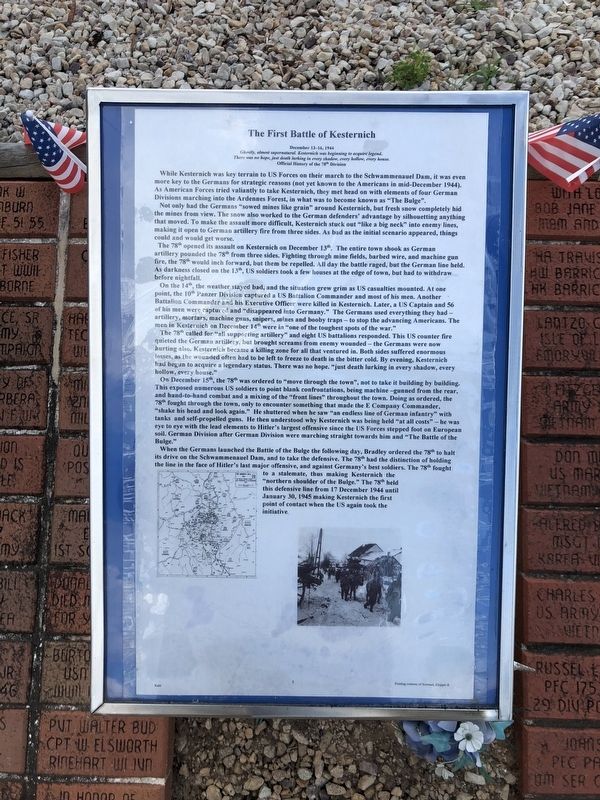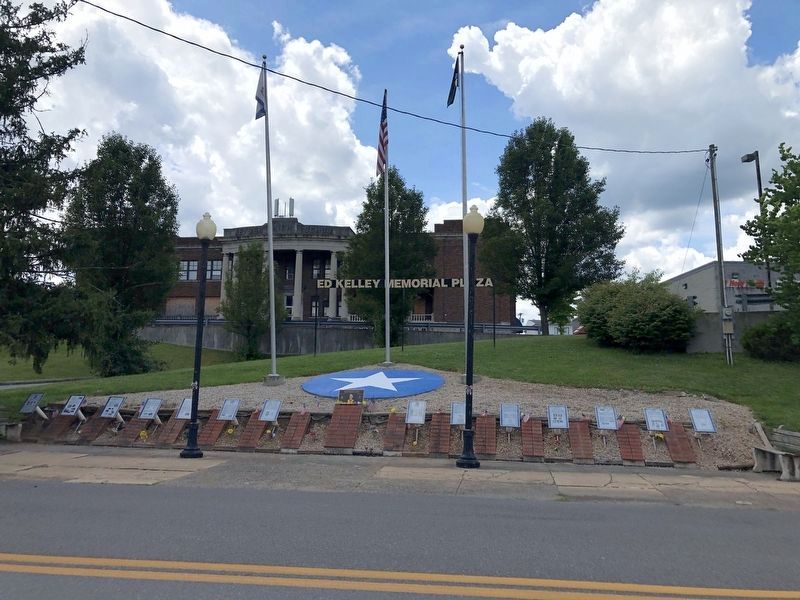Keyser in Mineral County, West Virginia — The American South (Appalachia)
The First Battle of Kesternich
December 13-16, 1944
Ghostly, almost supernatural, Kesternich was beginning to acquire legend. There was no hope, just death lurking in every shadow, every hollow, every house.
Official History of the 78th Division
While Kesternich was key terrain to US Forces on their march to the Schwammenauel Dam, it was even more to the Germans for strategic reasons (not yet known to the Americans in mid-December 1944). As American Forces tried valiantly to take Kesternich, they met head on with elements of four German Divisions marching in to the Ardennes Forest, in what was to become known as "The Bulge".
Not only had the Germans "sowed mines like grain" around Kesternich, but fresh snow completely hid the mines from view. The snow also worked to the German defenders' advantage by silhouetting anything that moved. To make the assault more difficult, Kesternich stuck out "like a big neck" into enemy lines, making it open to German artillery fire from three sides. As bad as the initial scenario appeared, things could and would get worse.
The 78th opened its assault on Kesternich on December 13th. The entire town shook as German artillery pounded the 78th from three sides. Fighting through mine fields, barbed wire, and machine gun fire, the 78th would inch forward, but them be repelled. All day the battle raged, but the German line held. As darkness closed on the 13th, US soldiers took a few houses at the edge of town, but had to withdraw before nightfall.
On the 14th, the weather stayed bad, and the situation grew grim as US casualties mounted. At one point, the 10th Panzer Division captured a US Battalion Commander and most of his men. Another Battalion Commander and his Executive Officer were killed in Kesternich. Later, a US Captain and 56 of his men were captured and "disappeared into Germany." The Germans used everything they had — artillery, mortars, machine guns, snipers, mines and booby traps — to stop the advancing Americans. The men in Kesternich on December 14th were in "one of the toughest spots of the war."
The 78th called for "all supporting artillery" and eight US battalions responded. This US counter fire quieted the German artillery, but brought screams from enemy wounded — the Germans were now hurting also, Kesternich became a killing zone for all that ventured in. Both sides suffered enormous losses, as the wounded often had to be left to freeze to death in the bitter cold. By evening, Kesternich had begun to acquire a legendary status. There was no hope. "just death lurking in every shadow, every hollow, every house."
On December 15th, the 78th was ordered to "move through the town", not to take it building by building. This exposed numerous US soldiers to point blank confrontations, being machine —gunned from the rear, and hand-to-hand combat and a mixing of the "front lines" throughout the town. Doing as ordered, the 78th fought through the town, only to encounter something that made the E Company Commander, "shake his head and look again." He shuttered when he saw "an endless line of German infantry" with tanks and self-propelled guns. He then understood why Kesternich was being held "at all costs" — he ws eye to eye with the lead elements to Hitler's largest offensive since the US Forces stepped foot on European soil. German Division after German Division were marching straight towards him and "The Battle of the Bulge."
When the Germans launched the Battle of the Bulge the following day, Bradley ordered the 78th to halt its drive on the Schwammenauel Dam, and to take the defensive. The 78th had the distinctions of holding the line in the face of Hitler's last major offensive, and against Germany's best soldiers. The 78th fought to a stalemate, thus making Kesternich the "northern shoulder of the Bulge." The 78th held this defensive line from 17 December 1944 until January 30, 1945 making Kesternich the first point of contact when the US again took the initiative.
Topics. This historical marker is listed in this topic list: War, World II . A significant historical date for this entry is January 30, 1945.
Location. 39° 26.382′ N, 78° 58.615′ W. Marker is in Keyser, West Virginia, in Mineral County. Marker is on West Piedmont Street just west of North Davis Street, on the left when traveling west. Touch for map. Marker is at or near this postal address: 32 N Davis St, Keyser WV 26726, United States of America. Touch for directions.
Other nearby markers. At least 8 other markers are within walking distance of this marker. The Battle of the Bulge (here, next to this marker); Key Terrain (here, next to this marker); Regaining the Initiative (here, next to this marker); D-Day (here, next to this marker); Jonah Edward Kelley (here, next to this marker); World War II (here, next to this marker); The Medal of Honor (here, next to this marker); Kelley Memorial Plaza (here, next to this marker). Touch for a list and map of all markers in Keyser.
Credits. This page was last revised on July 20, 2020. It was originally submitted on July 14, 2020, by Devry Becker Jones of Washington, District of Columbia. This page has been viewed 236 times since then and 48 times this year. Photos: 1. submitted on July 14, 2020, by Devry Becker Jones of Washington, District of Columbia. 2. submitted on July 14, 2020.

